A Comparison of Leavening Agents
by David Manthey (manthey@orbitals.com)
Copyright 2002 by David Manthey
A PDF version of this paper is available here: LEAVEN.PDF
Click on any picture in this paper to see a larger version.
Abstract
There are many different leavening agents available to the baker. These
include active dry yeast, sourdough starter, baking soda (sodium
bicarbonate), baking powder (baking soda, calcium phosphate, and sodium
aluminum sulfate), potash (potassium bicarbonate) or pearl ash, and bakers'
ammonia (ammonia carbonate). Each of these leaveners was tested by making a
biscuit containing flour, water, and the leavening agent. In addition, a
home-made potash was tried. For baking soda and the home-made potash, an
alternate set of biscuits were made with vinegar and water instead of just
water. Another set of biscuits contained only flour and water for use as a
control.
Three biscuits were made of each sort. Each was baked in a standard home
oven. The resulting baked biscuits were measured in diameter and height.
Variations in smell and taste are noted.
The yeast produced the largest biscuits. Many leavening agents produced
comparably tall biscuits, with the bakers' ammonia producing the tallest.
The worst rising biscuits were the unleavened ones, followed very closely by
the home-made potash and the sourdough.
Introduction
The home-baker has access to several different leaving agents. Baking
soda, baking powder, and active dry yeast are the three most common.
Specialty shops sell sourdough starter and bakers' ammonia. Historically
pearl ash or potash was used between at least the 1790s and the 1840s when it
was replaced by baking soda. Potash can still be obtained, though there are
also instructions on how to make it at home.
Although the comparative effect of baking soda and baking powder is often
discussed, there does not seem to be any more general comparison with other
leaveners. The following experiments make this comparison and also examine
the use of home-made potash.
A total of ten different sets of biscuits were made to test seven
different leaving agents. These were:
- Unleavened
- Baking soda
- Baking soda with vinegar
- Baking powder
- Bakers' ammonia
- Potassium bicarbonate
- Home-made potash
- Home-made potash with vinegar
- Active dry yeast
- Sourdough starter
Each of the leaving agents is detailed below.
The Leavening Agents
Baking Soda
Baking soda is also known as sodium bicarbonate or NaHCO3. The baking
soda used for these tests was Arm and Hammer brand, purchased at the local
grocery store. |
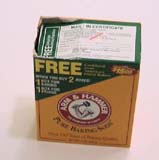 |
 |
Baking Powder
Baking powder is a combination of baking soda and a powdered acid. For
these tests, Davis double-acting baking powder was used, as purchased from
the local grocery store. This contains cornstarch as a filler, sodium
bicarbonate, calcium phosphate, and sodium aluminum sulfate. Calcium
phosphate is Ca(H2PO4)2, and sodium aluminum sulfate is NaAl(SO4)2. |
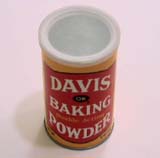 |
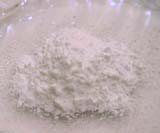 |
Bakers' Ammonia
Bakers' ammonia is ammonium carbonate or (NH4)2CO3. It is an
astonishingly noxious smelling substance. The bakers' ammonia was purchased
from King Arthur Flour, a mail
order baking supply company. It was manufactured by Lorann Oils. |
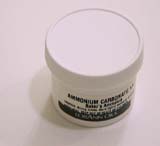 |
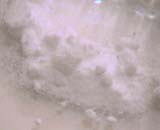 |
Potassium Bicarbonate
Potassium bicarbonate is one of the substances known as potash. This, as
well as potassium carbonate, is also known as pearl ash. It is KHCO3. The
potassium bicarbonate used in these tests was purchased at a home brewery
supply store. It is manufactured by Crosby and Baker, Ltd. |
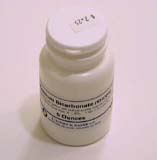 |
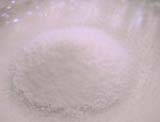 |
Home-made Potash
As per the instructions found at the Caveman to Chemist website
(http://cator.hsc.edu/~kmd/caveman/projects/potash/),
some potash was manufactured.
This was done by starting with wood ash made in a wood-burning stove.
Mixed hardwoods were used and the ash was collected from the ash grate. 250
g of ash were placed in a glass bowl with 2500 g of hot tap water
(approximately 50°C/120°F). This was stirred to mix thoroughly,
then allowed to settle for 12 hours.
The bowl now contained a sandy-looking precipitate, a small quantity of
charcoal floating on the surface, and some fairly clear but slightly colored
liquid (most likely tan, though the observer is incapable of distinguishing
color due to Daltonism). 1250 g of the colored liquid was withdrawn from the
bowl and placed in a stainless steel pot.
The liquid in the pot was brought to a roiling boil. It was boiled until
all liquid had evaporated and only a greyish residue remained. This residue
was scraped out of the bowl. A total of 22 g of residue was
obtained. |
 |
Active Dry Yeast
Yeast is readily available in a granulated form. The yeast used in these
tests was the Fleischmann brand, purchased at a local grocery store. |
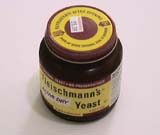 |
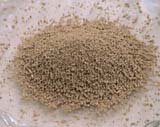 |
Sourdough Starter
Sourdough starter is generally a colony of wild yeast that is periodically
fed on flour and water. In this case, the starter has been actively
maintained and used for decades by the author. |
 |
Making Biscuits
To test the various leavening agents, a set of biscuits was made with each
agent. These biscuits consisted only of flour, water, and leavening. As a
control, a set of biscuits was made without any leavening. As the common
conception is that baking soda requires an acid to properly rise, an
additional set of biscuits was made with flour, baking soda, water, and
vinegar (acetic acid). As the home-made potash had very poor leaving on its
own, it too was tried with vinegar.
For all biscuits, the flour used was King Arthur unbleached all-purpose
white flour. Water was common tap water. Where used, vinegar was distilled
white vinegar with 5% acidity.
The basic biscuit recipe was as follows:
- 50 ± 0.5 g flour
- 35 ± 0.5 g water
- 2.7 ± 0.2 g leavening
For the unleavened biscuits, the same amount of flour and water was used but the leavening was
left out. For biscuits that used vinegar, the recipe was:
- 50 ± 0.5 g flour
- 32 ± 0.5 g water
- 3 ± 0.5 g vinegar
- 2.7 ± 0.2 g leavening
All measurements were done by weight using a Acculab V-6000 scale.
Three biscuits were made with each of the ten leavening combinations.
Each biscuit was formed by hand into an approximate disk with a height of 20
± 1 mm. The biscuits were baked in a pyrex dish for 12 minutes (±
2 seconds) at 205°C/400°F in a conventional home electric oven.
Based on the readings of a Fluke thermocouple, the oven averaged this
temperature with swings of ± 20°C/36°F.
After baking, the biscuits were removed from the pyrex dish using a
thin-bladed stainless steel spatula and placed on a wooden board to cool.
All measurements and analysis was done on the room temperature biscuits
(17°C/63°F).
Results
The height of each biscuits was measured to an accuracy of ± 0.5 mm.
While the biscuits were intended to be round, most were roughly oval. The
minimum and maximum diameter of each biscuit was measured to an accuracy of
± 2 mm. The low accuracy was caused by the irregular edges of some
biscuits. The heights and diameters are listed in a table after the
commentary on the biscuits.
In addition to measuring the biscuits, one biscuit of each type was
tasted, and the aroma of the biscuits was noted. These are very subjective
notes, completely dependent on one researcher. Any other significant
properties of the biscuits are noted.
An overall view and a cross section of each biscuit is shown. The overall
view was taken with a 640x480 resolution digital camera, while the cross
section was scanned at 300 dpi using a flatbed scanner.
Unleavened
The unbaked dough of the unleavened biscuit was mildly sticky. Baked, it
was still a bit damp, indicating that more baking was desirable.
The smell was very plain and ordinary, more of flour than anything else.
The taste was damp, bland, and doughy. |
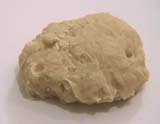 |
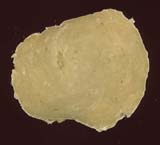 |
Baking Soda
This biscuit looked and felt very much the way a dough is expected to
behave.
The smell was a bit like pretzels. The taste was chewy, acrid, and in
need of salt. Taste-wise, the biscuit has too much baking soda in
it. |
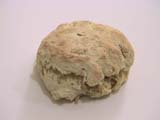 |
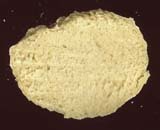 |
Baking Soda and Vinegar
The dough of this biscuit was a bit stickier than the plain baking soda
biscuit. Additionally, the dough rose a bit prior to baking.
The smell was very similar to the plain baking soda biscuits, though a bit
more pleasant. The taste was indistinguishable from the plain baking soda
biscuits. |
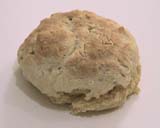 |
 |
Baking Powder
This biscuit was the closest to the archetypal biscuit. The dough was
pleasant to work with and the final biscuit was one of the most
attractive.
The smell is what one imagines a biscuit should smell like, while the
taste was nearly like that of bread. |
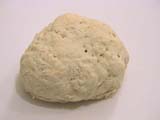 |
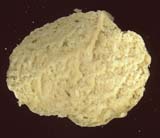 |
Bakers' Ammonia
The bakers' ammonia has a strong noxious smell. This made the dough
unpleasant to work with.
The smell of the baked biscuit has occasionally whiffs of ammonia, which
largely block a slight floury-smell. The taste is mildly chemical with an
occasional pungent ammonia bit. Overall, this was vile and disgusting.
According to the sales literature that accompanied the bakers' ammonia,
this compound is supposed to dissipate in the baking process. In the
researcher's limited experience, this never fully happens, and any baked good
always has pockets of noxious smelling and tasting ammonia.
Additionally, the biscuits left dark stains on the wooden board where they
were set to cool. |
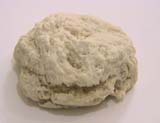 |
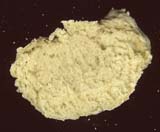 |
Potassium Bicarbonate
The potassium bicarbonate biscuit dough was nearly indistinguishable from
that of the baking soda biscuit.
The smell was flat and damp. There was almost no taste at first. There
was a slight acrid aftertaste. This probably indicates that too much
leavening was used. The biscuit is in need of salt. |
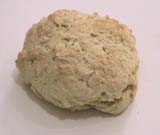 |
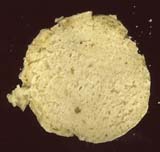 |
Home-made Potash
The dough was nearly identical to that of the baking soda biscuit. The
biscuit didn't rise very much at all.
After baking, the smell was damp and doughy. The taste was nearly
identical to the unleavened biscuit, but there was a faint flat
aftertaste. |
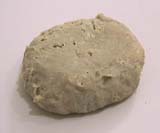 |
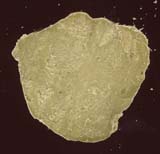 |
Home-made Potash with Vinegar
Aside from some initial frothing in the dough, this biscuit appeared
identical to the home-made potash without vinegar biscuit. |
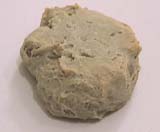 |
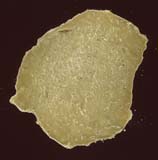 |
Active Dry Yeast
The dough of this biscuit was a bit wet, and therefore hard to shape.
The dough was left to rise for 60 minutes after the biscuits were formed.
Most of the rising occurred in this time.
The smell was yeasty. The taste was very similar to french bread
excepting that it was a bit yeasty. |
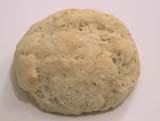 |
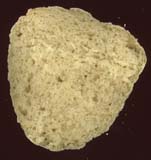 |
Sourdough
The sourdough starter looked insubstantial within the dough of this
biscuit. The dough was left to rise for 90 minutes after the biscuits were
formed.
The resulting biscuits did not rise much. There was almost no smell. The
taste was chewy and very slightly yeasty.
In general, much more sourdough starter is used when making a baked good.
Using an ounce of sourdough starter would have produced more desirable
results. |
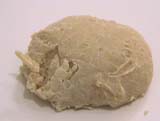 |
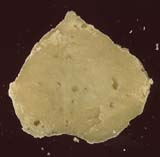 |
Measurements
The table below lists all biscuits and the measured values for each. In
addition to measuring the height and diameter, the area and volume of each
biscuit was computed. This was done using the cavalier assumption that the
biscuits were oval in area and ellipsoidal in volume; while this is certainly
not the case, it should provide a valid comparison to determine which
biscuits are largest.
| Table 1: Biscuit Measurements and Calculated
Values |
|---|
| Leavening | Height (mm) | Min. Diam. (mm) |
Max. Diam. (mm) | Area (mm2) |
Volume (cm3) |
|---|
| Unleavened |
26.0 | 62 | 75 | 3652 | 63.3 |
| 26.5 | 66 | 81 | 4199 | 74.2 |
| 25.5 | 63 | 72 | 3563 | 60.6 |
| Baking soda |
41.0 | 76 | 77 | 4596 | 125.6 |
| 44.0 | 72 | 78 | 4411 | 129.4 |
| 39.5 | 67 | 79 | 4157 | 109.5 |
| Baking soda and vinegar |
42.5 | 67 | 82 | 4315 | 122.3 |
| 41.0 | 73 | 77 | 4415 | 120.7 |
| 42.0 | 74 | 82 | 4766 | 133.4 |
| Baking powder |
40.5 | 75 | 90 | 5301 | 143.1 |
| 42.0 | 72 | 86 | 4863 | 136.2 |
| 40.0 | 75 | 86 | 5066 | 135.1 |
| Bakers' ammonia |
45.0 | 72 | 84 | 4750 | 142.5 |
| 48.5 | 67 | 80 | 4210 | 136.1 |
| 46.0 | 63 | 83 | 4107 | 125.9 |
| Potassium bicarbonate |
38.0 | 73 | 77 | 4415 | 111.8 |
| 40.5 | 69 | 76 | 4119 | 111.2 |
| 40.0 | 68 | 71 | 3792 | 101.1 |
| Home-made potash |
27.0 | 66 | 67 | 3473 | 62.5 |
| 27.0 | 64 | 74 | 3720 | 67.0 |
| 26.0 | 66 | 84 | 4354 | 75.5 |
| Home-made potash with vinegar |
29.0 | 63 | 73 | 3612 | 69.8 |
| 30.0 | 70 | 77 | 4233 | 84.7 |
| 28.0 | 70 | 77 | 4233 | 79.0 |
| Yeast |
39.0 | 88 | 92 | 6359 | 165.3 |
| 41.5 | 86 | 91 | 6147 | 170.1 |
| 38.0 | 86 | 98 | 6619 | 167.7 |
| Sourdough |
25.0 | 64 | 90 | 4524 | 75.4 |
| 27.0 | 74 | 81 | 4708 | 84.7 |
| 27.5 | 65 | 78 | 3982 | 73.0 |
Rankings
It is useful to examine which leaving agents rose highest, produced
biscuits with the greatest volume, and generated the widest biscuits. For
these purposes, the values of the three biscuits for each leaving agent were
averaged together. Tables 2 through 4 rank the various leavening agents
based on average height, area, and volume.
Based solely on height, bakers' ammonia produced the tallest biscuits. Of
the other leavening agents, baking soda with and without vinegar, baking
powder, potassium bicarbonate, and yeast all generated roughly equally high
biscuits. Home-made potash with vinegar showed a slight increase in height,
while the home-made potash without vinegar and the sourdough biscuits failed
to rise appreciably more than the unleavened biscuits. Unsurprisingly, the
unleavened biscuits were the shortest, though even these increased from 20 mm
to 26 mm.
Yeast raised biscuits had the largest area by a significant factor. Of
the rest, the baking powder biscuits were also significantly larger, though
much smaller than the yeast biscuits. Baking soda with and without vinegar,
sourdough, and bakers' ammonia all produced similarly sized biscuits.
Potassium bicarbonate wasn't as larger. The home-made potash was scarcely
better than the unleavened biscuits, though the vinegar helped a slight
amount.
Volumetrically, the yeast raised biscuits were clearly the largest.
Baking powder and bakers' ammonia came next. Baking soda, with and without
vinegar were smaller, but still respectable in size. Potassium bicarbonate
also produced a significant increase in volume. The home-made potash and
sourdough biscuits showed only a slight increase over the unleavened
biscuits.
| Table 2: Leavenings listed based on average height |
|---|
| Leavening | Avg. Height (mm) |
|---|
| Bakers' ammonia | 46.5 |
| Baking soda and vinegar | 41.8 |
| Baking soda | 41.5 |
| Baking powder | 40.8 |
| Potassium bicarbonate | 39.5 |
| Yeast | 39.5 |
| Potash with vinegar | 29.0 |
| Home-made potash | 26.7 |
| Sourdough | 26.5 |
| Unleavened | 26.0 |
|
| Table 3: Leavenings listed based on average area |
|---|
| Leavening | Avg. Area (mm2) |
|---|
| Yeast | 6375 |
| Baking powder | 5077 |
| Baking soda and vinegar | 4498 |
| Sourdough | 4405 |
| Baking soda | 4388 |
| Bakers' ammonia | 4356 |
| Potassium bicarbonate | 4108 |
| Potash with vinegar | 4026 |
| Home-made potash | 3849 |
| Unleavened | 3804 |
|
| Table 4: Leavenings listed based on average volume |
|---|
| Leavening | Avg. Volume (cm3) |
|---|
| Yeast | 167.7 |
| Baking powder | 138.1 |
| Bakers' ammonia | 134.9 |
| Baking soda and vinegar | 125.5 |
| Baking soda | 121.5 |
| Potassium bicarbonate | 108.1 |
| Potash with vinegar | 77.8 |
| Sourdough | 77.7 |
| Home-made potash | 68.3 |
| Unleavened | 66.0 |
|
Conclusion
Active dry yeast provided the largest increase in volume of any of the
leavening agents tested. Although bakers' ammonia produced the highest
rising biscuits, the noxious fumes that it releases are enough of a drawback,
that its use cannot be recommended. Baking powder was the next best quick
rising agent, with baking soda and potassium bicarbonate serving
adequately.
The addition of vinegar to biscuits with baking soda or home-made potash
increased their height and area to a small extent. The home-made potash was
a dismal failure as a leavening agent. The biscuits were larger than the
unleavened variety, and thus the home-made potash wasn't wholly worthless.
Neither the home-made potash nor the addition of vinegar appear to be worth
the effort of using them.
The tests used an identical baking time, an identical weight of leavening
agent, and an identical quantity of liquid for each biscuit. As a result,
some biscuits were underdone (such as the unleavened biscuits) while some
were adequately cooked. Some biscuits tasted of excess leavening (such as
the baking soda and potassium bicarbonate biscuits) while others did not have
enough leavening to rise much at all (specifically the sourdough biscuits).
Some biscuits had a sticky wet dough, while others had a dryish dough. It
would be useful to repeat some of these tests with biscuits that had been
more optimized for taste, texture, baking time, and leavening.
[ Manthey's Baking Page | Manthey Central | Orbital Central | Site Map ]































